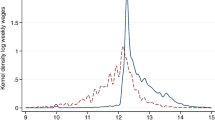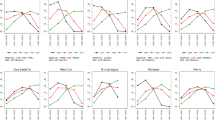Abstract
This paper examines empirically the effect of spatially concentrated poverty on minority youth employment and the role of “access” in youth labor markets. A model, in which information about jobs travels through social networks, links labor market outcomes and residential concentration of poverty. The empirical work uses U.S. Census employment data for the largest MSAs, in 1970 and 1980. The key findings are that, although concentration appears to have had no effect on black youth unemployment in 1970, the results for 1980 support “concentration effects” on unemployment for both black and hispanic youth. These effects are sizeable on average, and quite large in some cities.
Similar content being viewed by others
References
Bane MJ, Jarogowsky PA (1988) Urban poverty areas: basic questions concerning prevalence, growth and dynamics. In: McGeary M, Lynn L (eds) Concentrated inner-city poverty in America (Committee on National Urban Policy)
Boissevain J (1974) Friends of friends: Networks, manipulators and coalitions. St. Martins Press, New York
Bridges WP, Villemez WJ (1986) Informal hiring and income in the labor market. Am Sociological Rev 51:574–582
Corcoran M, Datcher L, Duncan G (1980) Information and influence networks in labor markets. In: Duncan G, Morgan J (eds) Five thousand families: patterns of economic progress, vol 8. Institute for Social Research, Ann Arbor
Datcher L (1982) The impact of informal networks on quit behavior. Rev Econ Statist 65:491–495
Fischer CS (1982) To dwell among friends: personal networks in town and city. University of Chicago Press, Chicago
Granovetter M (1974) Getting a job: a study of contacts and careers. Harvard University Press, Cambridge
Hill RE (1970) New look at employment referrals as a recruitment channel. Personnel J 49:144–148
Holzer HJ (1986) Informal job search and black youth unemployment. NBER Working paper No. 1860
Holzer HJ (1987) Hiring procedures in the firm: their economic determinants and outcomes. NBER Working paper No. 2185
Holzer HJ (1991) The spatial mismatch hypothesis: what has the evidence shown? Urban Stud 28:105–122
Kain J (1968) Housing segregation, negro employment, and metropolitan decentralization. Q J Econ 82:175–197
Massey DS, Eggers ML (1989) The ecology of inequality: minorities and the concentration of poverty 1970–1980. Population Research Center NORC/University of Chicago
Montgomery J (1988) Social networks and labor market outcomes: toward an economic analysis. MIT Department of Economics (unpublished paper)
Montgomery J (1989) Reinterpreting models of statistical discrimination: employee referrals and the role of social structure: MIT Department of Economics (unpublished paper)
Myers C, Shultze G (1951) The dynamics of a labor market. Prentice Hall, New York
Parnes HS (1954) Research on labor mobility: an appraisal of research findings in the United States. Social Science Research Council, New York
Rees A, Shultze G (1970) Workers and wages in an urban labor market. University of Chicago Press, Chicago
Sheppard HL, Belitsky AH (1966) The job hunt: job seeking behavior of unemployed workers in a local economy. Johns Hopkins Press, Baltimore
Staiger D (1990) The effect of connections on the wages and mobility of young workers. MIT Department of Economics (unpublished paper)
Ullman JC (1966) Employee referrals: prime tools for recruiting workers. Personnel 43:30–35
Wellman B (1983) Network analysis: some basic principles. In: Collins R (ed) Sociological theory 1983. Jossey-Bass, San Francisco
Wellman B, Leighton B (1979) Networks, neighborhoods, and communities: approaches to the study of the community question. Urban Affairs Q 14:3 363–390
White MJ (1988) American neighborhoods and residential differentiation. Russell Sage Foundation, New York
Wilson WJ (1987) The truly disadvantaged: the inner city, the underclass, and public policy. University of Chicago Press, Chicago
Author information
Authors and Affiliations
Rights and permissions
About this article
Cite this article
O'Regan, K.M. The effect of social networks and concentrated poverty on black and hispanic youth unemployment. Ann Reg Sci 27, 327–342 (1993). https://doi.org/10.1007/BF01583572
Received:
Accepted:
Issue Date:
DOI: https://doi.org/10.1007/BF01583572




